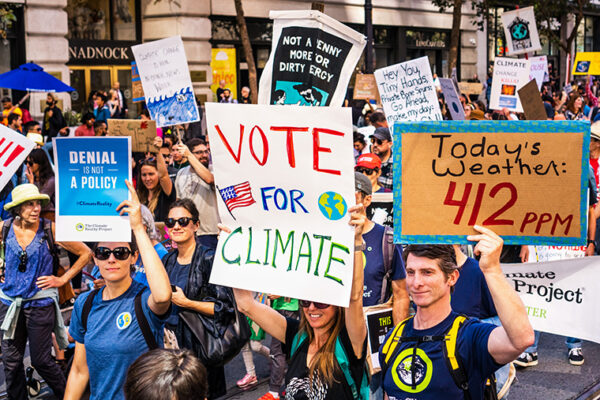Geophysicist Michael Wysession, professor of earth and planetary sciences in Arts & Sciences at Washington University in St. Louis, teaches a popular undergraduate course called “Energy and the Environment” and is author of The Great Courses lecture series “The Science of Energy: Resources and Power Explained.” Here Wysession breaks down President-elect Joe Biden’s 9-point energy plan, point-by-point, and provides his perspective on what is most doable:
“Anything Biden does will be a vast improvement.”
Michael Wysession
- “Reverse the Trump damage and then some. Biden wants to initiate, reinstate and/or increase vehicle fuel economy standards, methane pollution limits and bans on new oil and gas leases. Car companies have been focusing their R&D on meeting high mileage standards, particularly by a shift to electric vehicles (EVs), so they don’t mind high standards as long as the playing field is level. Big petroleum companies are frustrated with the lack of compliance by smaller fracking firms, so they support stricter methane release controls. The lack of enthusiasm by oil companies for the sale this month of oil leases in the Arctic National Wildlife Refuge was stunning. This is all doable.
- “Push legislation toward economy-wide net-zero greenhouse gas emissions by 2050. Any legislation in today’s incredibly partisan U.S. Congress is a challenge, but particularly on this contentious topic. However, technological advances have made wind and solar power cheaper than any fossil fuel, including natural gas, and there are now multiple pathways for this to happen, as identified in last month’s report from Princeton University’s ‘Net-Zero America’ project. Possible.
- “Re-engaging with other countries on climate efforts, including rejoining the Paris accords. Rejoining is not as easy as you might think, but four years gives this administration plenty of time. Biden will have a tougher time convincing other countries that he can set enough things in motion to prevent another major setback should an administration as anti-science as Trump’s return in 2024. Likely.
- “Invest $400 billion over 10 years in clean energy and innovation. For the past 50 years, U.S. presidents have always invested in energy sources in one form or another. The government supported about $100 billion in energy-related R&D during 1973-2002, with half going toward nuclear power and the rest split between fossil fuels and renewables. The second Bush administration shifted this in 2002-08, spending nearly all of $72 billion on subsidies for coal, oil, gas or corn-based ethanol. The Obama administration shifted the other way, spending 75% of energy funding on renewable energy technologies and energy efficiency, and we can expect more of the same from Biden. However, $400 billion is a huge amount of money — about twice the cost of the Apollo program in today’s dollars, and the economy is too badly wounded to start this any time soon. Too ambitious; partial success.
- “Accelerate the deployment of clean energy technology within the U.S. economy. Biden wants to make buildings more energy efficient and install half a million public EV charging stations by 2030. This is strongly supported by Biden’s proposed nominee for Secretary of Energy, former Michigan Gov. Jennifer Granholm, an effective leader who pushed for EVs in Motown as a way to create jobs and boost the economy during the killer recession a decade ago. Granholm’s focus has long been in moving away from fossil fuels and toward renewable energy sources. Biden credits her with saving the Detroit auto industry and a very large number of jobs. And everybody likes jobs. If Biden successfully delivers on establishing an Advanced Research Projects Agency-Climate (ARPA-C), it will be a big boon for R&D in all renewable energy tech areas (nudge, nudge, McKelvey School of Engineering!). Very likely.
- “Make environmental justice a priority across all federal agencies. Enter Granholm, again: Part of her big push for major wind and solar power projects in Michigan was based on the historic inequities of health and environmental impacts of fossil fuels on minority communities. Biden’s future administration runs on diversity. Granholm (who is from Canada) and the nominee for DOE Deputy Director Arum Majumdar (who is from India), a Stanford professor of engineering who started the Advanced Research Projects Agency-Energy (ARPA-E) under Obama/Biden, are both immigrants: They’ll get the job done.
- “Hold polluters accountable. Biden will direct the EPA and Justice Department to pursue corporations involved with large greenhouse gas emissions. This kind of litigation is complex and slow, but it might help push major U.S. oil companies to begin to embrace renewable energies (the way their European counterparts already have). Not likely, but may scare corporations to change old practices.
- “Create 10 million good-paying, middle-class, clean-energy union jobs. Obama created a total of 12.5 million jobs in eight years; Biden wants more than this in four, with 10 million in energy. However, Biden’s plan encompasses a full overhaul of the energy industry, including modernizing the electric grid (a big priority for Majumdar), building small modular nuclear reactors, decarbonizing agriculture and heavy industry, and enacting carbon capture and storage, as well as developing wind and solar at all scales. That would mean a lot of jobs. It also would mean borrowing a lot more against the national debt. Too ambitious; maybe in eight years.
- “Repair fossil fuel industry communities. Biden is committed to helping coal communities in areas of health (with black lung programs) and employment (with modern job retraining efforts). However, Biden needs the votes from Joe Manchin, moderate Democratic senator from the big coal state of West Virginia. This should do it. Likely.”
In sum, Wysession notes that Biden’s plans are very aggressive, but many items are likely to succeed. With the game-changing recent senate victories in Georgia, these aspirations have become much more possible.
“Trump’s energy ‘policy’ ranged from non-existent to ignorant, with reactionary (and failed) attempts to bolster the collapsing coal industry and sell off protected land for oil and gas leases,” Wysession said.
“Anything Biden does will be a vast improvement,” he said. “With wind and solar having already reached grid parity, the future’s so bright you gotta wear shades. Let’s just hope all of Washington’s Republicans haven’t gone blind from staring at eclipses.”
Read more from WashU experts regarding an array of policies and initiatives ahead in the new administration’s first 100 Days.



